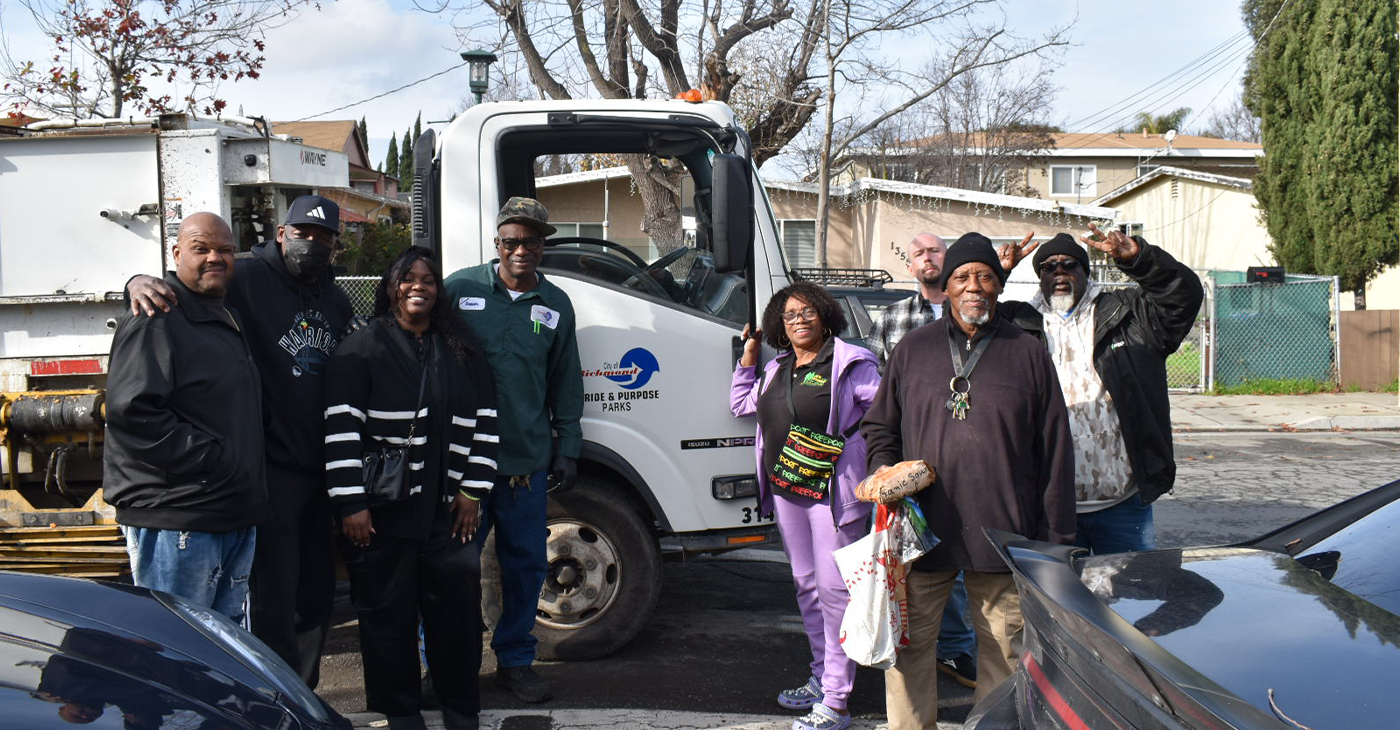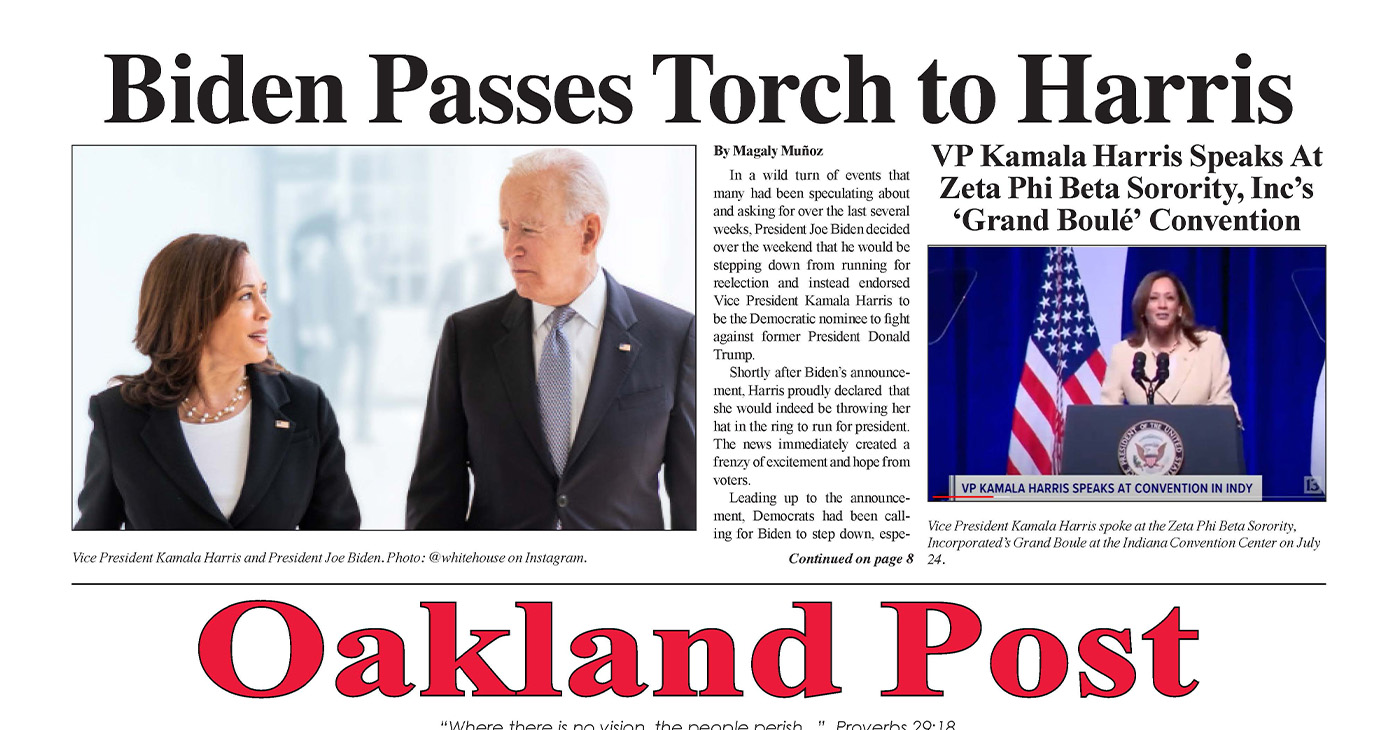Community
Richmond Nonprofit Helps Ex-Felons Get Back on Their Feet
For 20 years now, at a small center in North Richmond, Men and Women of Valor (MVOV) has been helping to rehabilitate ex-felons, giving them a second chance at life. Pam Saucer, the founder and CEO of MWOV, has long been a leader in the community, advocating for — and educating — at-risk youth and formerly incarcerated men and women.

By Magaly Muñoz
For 20 years now, at a small center in North Richmond, Men and Women of Valor (MVOV) has been helping to rehabilitate ex-felons, giving them a second chance at life.
Pam Saucer, the founder and CEO of MWOV, has long been a leader in the community, advocating for — and educating — at-risk youth and formerly incarcerated men and women.
The center offers these newly released ex-felons opportunities to get their GED, participate in community service projects, and obtain transitional housing while they get back on their feet.
“We’re giving back to the community and have had a positive impact. We go as far as cleaning up the area because you have to have a clean heart and a clean mind to want to do something productive,” Saucer said.
Take the case of Kiaira Fluker, 35, who had a probation violation in 2019 that caused her to spend 105 days in jail. After that experience, Fluker swore she’d do everything she could to never go back.
Fluker shared that she was referred to MWOV and, soon after, she learned about the rehabilitation program Saucer ran.
Fluker said the program provided her with job opportunities and life skills that have allowed her to stabilize herself and her three kids, who often visit the center as well. Being around the team at the center created a positive atmosphere for Fluker and made her realize that the people she was surrounding herself with in her past was not what she needed in her life anymore.
“I was blessed. If I hadn’t found Ms. Pamela, I would’ve lost everything from my housing and probably custody of my children,” Fluker said.
Although the center has been operating since 2005, Saucer’s work with disadvantaged youth and the formerly incarcerated has gone beyond the Richmond center. Many of the volunteers working there had known her for years before she took on the challenge of running her own organization.
Antayon Alexander, one of MWOV’s volunteers, shared that he has worked with Saucer since the ’90s and that she helped him develop the skills to run a transitional housing unit in Sonoma for two years.
Alexander had served three years in prison on a narcotics charge and has been on parole for over 30 years. He wasn’t proud of where he wound up at such a young age and did the work “day-in-and-day out” to not end up back in prison.
Alexander stressed to the men in the housing that this was their opportunity for a second chance at life and to better themselves, similar to his own experience after meeting Saucer. Alexander could relate to them on a level of understanding that transitioning out of incarceration was never easy work, but it was up to them to maintain clean and healthy paths in order to not recommit their crimes.
“We were all cut from the same cloth,” he said.
Alexander had spent a few years with Richmond Unified School District working with kids in group homes and running a special education school. He wants to work towards starting his own nonprofit, similar to MWOV, to continue giving back to the community in the way he knows best.
To ease the growing costs of gas and in some cases, not being able to obtain a drivers’ license because of prior convictions, MWOV is partnering with the city of Richmond to potentially build an e-bike rack outside of the center to make it more accessible for those in the area to get to doctors, appointments, job interviews, work or school. The program is called “Ride Today” and will feature five access points around Central Richmond with over 70 bikes.
Saucer says the e-bikes will be available at a low-cost or with a free membership for those involved with MWOV.
The center shows no signs of slowing down soon as they take on new projects regularly, including inviting aspiring musicians to use their onsite music studio, partnering with community members to provide vocational truck driving lessons, and hosting a celebrity fundraising competition with well-known Bay Area rapper, E-40, in March.
Activism
Oakland Post: Week of July 24 – 30, 2024
The printed Weekly Edition of the Oakland Post: Week of July 24 – 30, 2024

To enlarge your view of this issue, use the slider, magnifying glass icon or full page icon in the lower right corner of the browser window. ![]()
#NNPA BlackPress
NNPA NEWSWIRE — Reflecting on his long career, Biden expressed deep gratitude and pride. “Nowhere else on earth could a kid with a stutter from modest beginnings in Scranton and Claymont one day sit behind the Resolute Desk in the Oval Office. But here I am. That’s what makes America special,” he remarked, his voice tinged with emotion.
The post first appeared on BlackPressUSA.

Biden: Our Democracy Demands New Leadership
By Stacy M. Brown, NNPA Newswire Senior Correspondent
@StacyBrownMedia
In an impassioned address from the Oval Office, President Joe Biden laid bare his decision to step down from the 2024 presidential race, urging Americans to embrace a new generation of leadership. “Saving democracy is more important than any title. It’s time to pass the torch to younger voices,” Biden declared in an address that signaled a transformative shift in American politics.
Following his decision over the weekend to bow out of the race for re-election, Biden’s announcement was a clarion call for renewal. Stressing the moment’s urgency, Biden emphasized that the future of democracy depends on fresh, dynamic leadership. He endorsed Vice President Kamala Harris as the embodiment of this new era. “Years ago, I described myself as a transitional candidate, and now it’s time for that transition to take full effect,” Biden said, positioning Harris as the future of the Democratic Party.
While refraining from mentioning former President Donald Trump by name, Biden clarified that he views the twice impeached and 34 times convicted felon Republican presidential nominee as a fundamental threat to democratic values. “My record as president, my leadership on the global stage, and my vision for America’s future all merited a second term,” Biden stated. “But nothing can stand in the way of safeguarding our democracy. That includes personal ambition. So, I’ve decided the best path forward is to pass the torch to a new generation.”
Reflecting on his long career, Biden expressed deep gratitude and pride. “Nowhere else on earth could a kid with a stutter from modest beginnings in Scranton and Claymont one day sit behind the Resolute Desk in the Oval Office. But here I am. That’s what makes America special,” he remarked, his voice tinged with emotion.
Biden acknowledged that doubts about his ability to defeat Trump influenced his decision. “I revere this office, but I love my country more,” he said. “It’s been the honor of my life to serve as your president. But in defense of democracy, which is at stake, I think it’s more important than any title.”
Biden said he is determined to address crucial issues for the remainder of his term. His agenda includes lowering family costs, defending personal freedoms, protecting voting rights, combating cancer, addressing gun violence, and advocating for Supreme Court reform. Internationally, he said he aims to strengthen NATO, support Ukraine, and seek an end to the conflict in Gaza.
Biden’s endorsement of Harris has galvanized the Democratic Party, with Harris swiftly securing the backing of a majority of Democratic delegates. “I’m not going anywhere,” Biden reassured his campaign staff, now supporting Harris. “I’m going to be out there on the campaign trail with her, working tirelessly as both a sitting president and a campaigner.”
The landmark address, along with Biden’s anticipated speech at the Democratic National Convention, could prove pivotal in defining his legacy. “In a few months, Americans will decide the direction of our nation’s future,” Biden stated. “I have made my choice. I’ve expressed my views. Now the decision is in your hands, the hands of the American people.”
In the days before his decision, Biden confided in close advisors about his concerns regarding another run against Trump. His acknowledgment of those doubts underscored his commitment to putting the country’s needs above his ambitions. “The defense of democracy must come before all else,” he reiterated.
As Biden prepares to support Harris in her campaign, he remains focused on his presidential duties. His administration continues to push for significant legislative achievements, reinforcing his enduring commitment to the American people. “In just a few months, the American people will choose the course of America’s future,” Biden said. “The great thing about America is here, kings and dictators do not rule. The people do. History is in your hands. The power is in your hands. The idea of America lies in your hands.”
The post first appeared on BlackPressUSA.
#NNPA BlackPress
PRESS ROOM: Reparations Movement Partners Globally Mourn the Passing of U.S. Congresswoman Sheila Jackson-Lee
NNPA NEWSWIRE — we acknowledge the powerful legacy of U.S. Congresswoman Sheila Jackson-Lee. She was a steadfast leader in the fight for reparatory justice, carrying forward the legislative baton from the late U.S. Congressman John Conyers in 2018.
The post PRESS ROOM: Reparations Movement Partners Globally Mourn the Passing of U.S. Congresswoman Sheila Jackson-Lee first appeared on BlackPressUSA.

[July 22, 2024 – Chicago, IL] With an extremely heavy heart and a profound sense of loss, we acknowledge the powerful legacy of U.S. Congresswoman Sheila Jackson-Lee. She was a steadfast leader in the fight for reparatory justice, carrying forward the legislative baton from the late U.S. Congressman John Conyers in 2018. Her relentless efforts nearly brought HR 40 to passage in the House of Representatives in 2022, missing by just one vote. Her leadership was pivotal in advancing the bill out of the Judiciary Committee in April 2021 after a historic debate. Even after her diagnosis, Rep. Jackson-Lee fiercely collaborated with reparations leaders, pushing for President Biden to establish an HR40-like commission by Executive Order. She believed this executive path was crucial for addressing centuries of injustice. Despite setbacks in meetings with the President’s team, she remained optimistic and urged us to stay ready for progress.
The Earn the Black Vote Collaborative formed in 2023 in response to her urging to continue the fight for reparations. On April 25, 2024, the Collaborative released a poll showing significant support for President Biden to issue an Executive Order for Reparations. Congresswoman Jackson-Lee championed the poll’s findings, emphasizing the critical importance of reparations to African American and progressive communities. Her vision was clear: an Executive Order to create a federal reparations commission could drive transformative Black voter turnout and move the ball toward justice. She had wanted the Executive Order done by Juneteenth. Tragically, just a month after Juneteenth, she left us. We have lost a great leader for reparatory justice. In honor of her legacy, we call for the establishment of the Executive Order by President Biden. We extend our deepest condolences to Representative Jackson-Lee’s family. We call on reparation activists, leaders, and legislators globally to stand with us as we honor her legacy. May the Ancestors and the Creator receive her with joy.
About the Author:
Kamm Howard is a national and international reparations scholar and activist working for over 20 years building grassroots movements to obtain reparations for African descendants in the United States.
CONTACT:
Reparations United Phone: 773-985-2990
Email: kamm@reparationsunited.org Website: https://reparationsunited.org/
The post PRESS ROOM: Reparations Movement Partners Globally Mourn the Passing of U.S. Congresswoman Sheila Jackson-Lee first appeared on BlackPressUSA.
-

 Arts and Culture3 weeks ago
Arts and Culture3 weeks agoRooted in Tradition: The Intricate History of Black Hair Braiding
-

 Bay Area4 weeks ago
Bay Area4 weeks ago“I Will Not Be Bullied,” Says Oakland Mayor Sheng Thao
-

 Bay Area2 weeks ago
Bay Area2 weeks agoPG&E Increases Rates While Bay Area Households Are Struggling to Stay Afloat
-

 Business3 weeks ago
Business3 weeks agoGov Newsom: Raising Fast Food Minimum Wage to $20 Pays Off as Jobs Multiply in Industry
-

 Activism4 weeks ago
Activism4 weeks agoOpponents of Mayor Sheng Thao Are Calling on Her to Resign Following FBI Raid
-

 Bay Area2 weeks ago
Bay Area2 weeks agoJuneteenth Mass Shooting Suspect Charge with Multiple Counts of Felony Assault by Alameda County DA Pamela Price
-

 Community1 week ago
Community1 week agoHundreds Come to Jehovah’s Witnesses’ Assembly Hall for Three-Day Program of ‘Good News’ in Fremont
-

 Activism4 weeks ago
Activism4 weeks agoOakland Coliseum Sale to AASEG: A Model for Community Development and Inclusion


















































